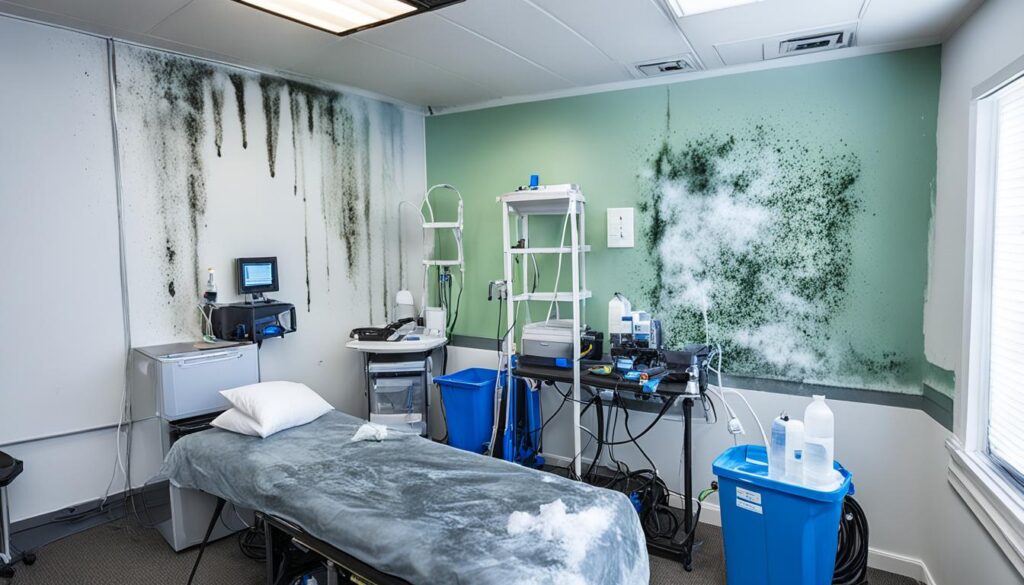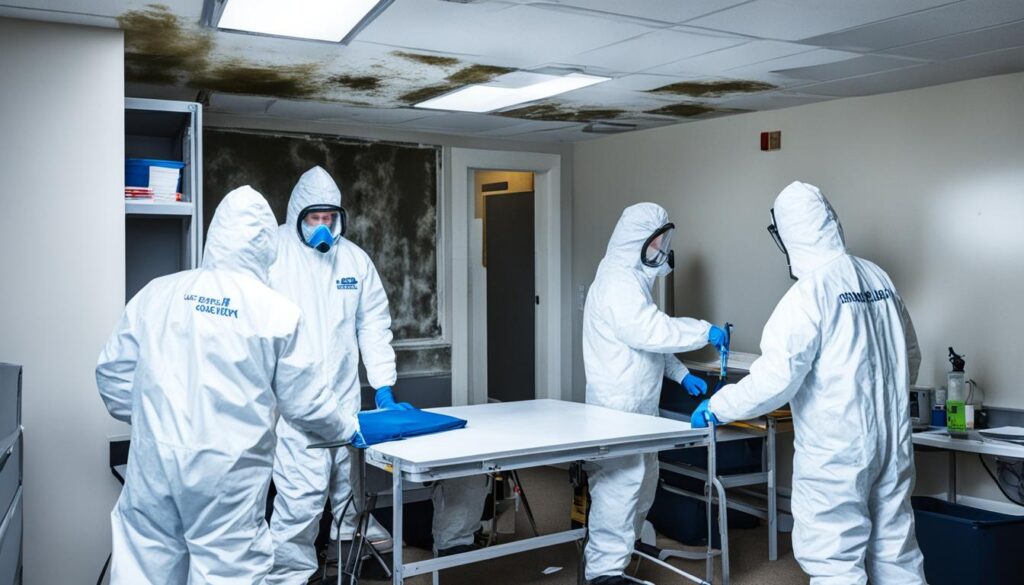
Mold Remediation for College Dorms: Safe Strategies
Welcome to our guide on mold remediation for college dorms. As a college student, dealing with mold in your dormitory can be both uncomfortable and harmful to your health. That’s why it’s essential to implement effective strategies to create a safe and mold-free living environment. In this article, we will provide you with valuable insights on how to identify, address, and prevent mold problems in college dorms.
Mold growth in dormitories can lead to various health risks, including respiratory issues, allergies, and asthma. By understanding the risks associated with mold exposure, you can take proactive steps to protect yourself and ensure your well-being. We will discuss these risks in detail and provide practical tips on how to manage mold growth in your student living spaces.
Identifying and addressing mold problems in college dorms is crucial for maintaining a healthy environment. We will guide you through the process of identifying mold growth, providing step-by-step instructions on how to remove mold from your dorm room. Additionally, we will address any underlying issues that may contribute to mold growth and help you tackle them effectively.
Prevention is always better than cure, and the same goes for mold in college dorms. By taking preventive measures, you can minimize the chances of mold growth and create a safe environment for yourself and your roommates. We will share practical tips and recommendations on how to prevent mold in college dorms, helping you maintain a mold-free living space throughout your academic journey.
While you can handle some mold issues on your own, certain situations may require professional assistance. We will explain when it’s necessary to seek help from experts and provide guidance on finding reputable mold remediation services. Your health and safety are of utmost importance, and involving professionals can ensure the proper and effective remediation of mold in your college dorm.
In conclusion, implementing effective strategies for dealing with mold in college dorms is vital for the well-being of students. By understanding the risks, identifying and addressing mold problems, taking preventive measures, and seeking professional assistance when needed, you can create a healthy living environment for yourself and your fellow students. Now, let’s delve into the details and equip you with the knowledge to combat mold in your college dormitories.
Key Takeaways:
- Implement effective strategies to create a safe and mold-free living environment in college dorms.
- Understand the health risks associated with mold exposure and take proactive steps to manage mold growth.
- Identify and address mold problems in dorm rooms using step-by-step instructions for safe and thorough mold removal.
- Prevent mold growth by maintaining cleanliness, controlling moisture levels, and proper ventilation in your dormitory.
- Seek professional assistance for complex mold issues to ensure proper remediation and a healthy living environment.
Understanding the Risks of Mold in Dorms
Mold growth in dormitories poses a significant risk to the health and well-being of college students. Understanding the potential dangers of mold exposure is crucial for students living in shared spaces. Without proper prevention and management, mold can lead to various health issues and negatively impact the overall quality of student living spaces.
Here are some essential mold prevention tips for students to effectively manage mold growth in their dorms:
- Keep the dorm room clean and dry: Regularly clean and dry the dorm room to prevent mold growth. Clean up spills and address water leaks promptly to maintain a dry environment.
- Proper ventilation: Ventilate the room by keeping windows open or using fans to improve air circulation and prevent excessive moisture buildup.
- Control humidity levels: Use dehumidifiers or air conditioners to control humidity levels in the dorm room, ideally maintaining levels below 60%. High humidity creates a favorable environment for mold growth.
- Mold-resistant products: Use mold-resistant bedding, mattresses, and shower curtains to mitigate mold growth in these common areas.
- Report maintenance issues promptly: If you notice any signs of mold or water damage in your dorm room, report it to the housing authorities immediately. They can take the necessary steps to address the issue.
By following these mold prevention tips, students can create a healthier living space and reduce the risk of mold-related health problems. Remember, prevention is key when it comes to managing mold growth in student living spaces.
“Preventing mold growth in dormitories is crucial for the well-being of college students. By implementing simple preventive measures, students can create a healthier living environment and minimize the risks associated with mold exposure.”
Preventing Mold in Shared Spaces
Shared spaces in dormitories, such as kitchens and bathrooms, require extra attention to prevent mold growth. Here are some additional tips for students to manage mold in these shared areas:
- Regularly clean and disinfect shared surfaces to prevent mold spores from settling and growing.
- Wipe down bathroom surfaces after use to remove excess moisture and prevent mold growth.
- Use exhaust fans in bathrooms and kitchen areas to reduce humidity levels.
- Store food properly and promptly clean up any spills to prevent mold growth in the kitchen.
By implementing these preventive measures, students can effectively manage mold growth in both their individual dorm rooms and shared living spaces.
Identifying and Addressing Mold Problems
In college dormitories, the presence of mold can be a common issue due to various factors such as poor ventilation, high humidity levels, and inadequate maintenance. To ensure a safe and healthy living environment for students, it is crucial to promptly identify and address mold problems. This section will provide step-by-step instructions on how to remove mold from dorm rooms and effectively address any underlying issues that may be causing mold growth.
1. Visual Inspection
The first step in identifying mold problems in your dorm room is to conduct a visual inspection. Look for signs of mold growth, including black or green patches on walls, ceilings, or surfaces. Pay attention to areas that are prone to moisture, such as bathrooms, kitchens, and laundry areas. In addition, check for musty odors, as it could indicate hidden mold growth.
2. Document and Report
If you come across mold in your dorm room, it is essential to document the problem by taking photos or videos. This evidence will be valuable when reporting the issue to the college or university housing authorities. Promptly inform the relevant parties about the mold problem, providing detailed information about the location and extent of the mold growth.
3. Proper Ventilation
To address mold issues, it is crucial to improve ventilation in your dorm room. Ensure that windows can be opened to allow fresh air circulation and reduce humidity levels. Consider using fans or dehumidifiers to maintain optimal moisture levels and prevent mold growth.
4. Remove Mold Safely
When removing mold from your dorm room, it is essential to prioritize safety. Wear protective gear such as gloves, goggles, and a mask to prevent exposure to mold spores. Use a mixture of water and detergent to scrub the affected surfaces gently. Avoid using bleach, as it can be harmful and may not effectively eliminate mold. Dispose of any porous materials that cannot be thoroughly cleaned, such as carpets or upholstery.
5. Address Underlying Issues
Mold growth is often a result of underlying issues such as water leaks or excessive condensation. To prevent future mold problems, it is necessary to address these underlying issues. Report any leaks or plumbing problems to maintenance or housing authorities immediately. Ensure proper ventilation in areas prone to moisture, such as bathrooms, by using exhaust fans or opening windows during and after showering.
By following these mold removal techniques for dorm rooms and addressing underlying issues, you can effectively combat mold growth in college housing. However, if the mold problem persists or covers a large area, it is advisable to seek professional assistance from mold remediation experts.

Preventive Measures for Mold in College Dorms
Preventing mold growth in college dormitories is crucial for maintaining a healthy living environment for students. By implementing proactive measures and following some essential mold prevention tips, students can minimize the risk of mold and create a mold-free space conducive to their well-being.
Evaluate Ventilation and Moisture Control
Adequate ventilation is vital in preventing mold growth. Ensure that windows and doors are properly sealed to prevent moisture from seeping in. Additionally, use fans or dehumidifiers to regulate humidity levels and inhibit mold growth.
Keep Dorm Rooms Clean and Organized
Maintaining cleanliness in your dorm room is essential for mold prevention. Regularly clean surfaces, including floors, desks, and countertops, to remove any potential mold spores. Keep belongings organized to prevent clutter that could trap moisture and promote mold growth.
Monitor and Address Plumbing Issues Promptly
Leaky pipes or faucets can lead to moisture accumulation and create an ideal environment for mold to thrive. If you encounter any plumbing issues, report them to your dormitory management immediately for timely repairs and prevention of mold growth.
Use Mold-Resistant Bedding and Mattress Protectors
Investing in mold-resistant bedding and mattress protectors can help reduce the risk of mold growth in your dorm room. These products are specifically designed to repel moisture and inhibit mold and mildew development.
Avoid Carpeting in Dorm Rooms
Carpeting can easily trap moisture and promote mold growth. Opt for hard flooring surfaces, such as tile, laminate, or vinyl, which are easier to clean and less prone to mold issues.
Properly Maintain Personal Items
Take care of your personal belongings to prevent them from becoming breeding grounds for mold. Dry wet shoes, clothing, and towels thoroughly before storing them in your dorm room. Additionally, regularly clean and inspect items such as backpacks, electronics, and books for any signs of mold growth.
Communicate with Roommates and Dormitory Management
Open and effective communication with your roommates and dormitory management is crucial in preventing mold issues. Discuss and establish guidelines for maintaining a clean and mold-free environment. Promptly report any concerns or signs of mold growth to the appropriate authorities for immediate remediation.
Implementing these preventive measures can significantly reduce the risk of mold growth in college dorms, ensuring a healthy and comfortable living space for students.
By following these mold prevention tips, college students can create a conducive living environment that promotes their well-being and helps prevent the development of mold-related health issues.
To learn more, please refer to the table below for a summary of key preventive measures:
| Preventive Measures | Description |
|---|---|
| Evaluate Ventilation and Moisture Control | Ensure proper airflow and regulate humidity levels to inhibit mold growth. |
| Keep Dorm Rooms Clean and Organized | Maintain cleanliness and prevent clutter to minimize mold-friendly environments. |
| Monitor and Address Plumbing Issues Promptly | Report and repair any plumbing problems to prevent moisture buildup. |
| Use Mold-Resistant Bedding and Mattress Protectors | Invest in bedding and protectors specifically designed to resist mold and moisture. |
| Avoid Carpeting in Dorm Rooms | Choose hard flooring surfaces that are less prone to trapping moisture. |
| Properly Maintain Personal Items | Dry and clean personal belongings before storing them to prevent mold growth. |
| Communicate with Roommates and Dormitory Management | Establish guidelines and promptly report any concerns or signs of mold growth. |
Seeking Professional Assistance for Mold Remediation
Coping with mold exposure in student accommodations can be a challenging and stressful experience. When mold becomes a persistent problem in your college dorm, it’s essential to seek professional assistance for effective mold remediation. While some minor mold issues can be handled by students themselves, there are instances when the expertise of mold remediation professionals is crucial.
If you notice extensive mold growth or suspect hidden mold, it’s prudent to involve experts who can properly assess the situation and develop a thorough remediation plan. Professional mold remediation services have the necessary knowledge, tools, and experience to handle complex mold problems in student accommodations.
When choosing a mold remediation service, it’s important to consider the following:
- Experience: Look for companies with a proven track record and years of experience in the industry. They should have a deep understanding of mold-related issues in student living spaces.
- Certifications and Training: Ensure that the mold remediation professionals are certified by reputable organizations, such as the Institute of Inspection, Cleaning and Restoration Certification (IICRC) or the National Association of Mold Professionals (NAMP).
- Remediation Process: Inquire about their approach to mold remediation, including their assessment methods, containment strategies, removal techniques, and post-remediation testing. A comprehensive and systematic process is crucial for effective mold removal.
- Insurance and Licensing: Verify that the mold remediation company carries appropriate insurance coverage and holds the necessary licenses and permits for operating in your area.
- References and Reviews: Request references from past clients or read online reviews to gauge the reputation and reliability of the mold remediation service.
By engaging professionals with expertise in mold remediation, you can have peace of mind knowing that your mold problem will be properly addressed, minimizing the risk of exposure and ensuring a safe living environment for you and your fellow students.
“Professional mold remediation services have the necessary knowledge, tools, and experience to handle complex mold problems in student accommodations.”

| Benefits of Professional Mold Remediation Services | DIY Mold Remediation |
|---|---|
| Thorough identification and assessment of mold problems | May overlook hidden mold or fail to properly address the cause of the issue |
| Effective containment and removal of mold | May result in inadequate mold removal, leading to regrowth |
| Compliance with industry standards and regulations | May not follow recommended protocols, increasing the risk of incomplete remediation |
| Advanced equipment and techniques for mold removal | Limited access to specialized tools and equipment |
| Post-remediation testing to ensure complete eradication of mold | No guarantee of thorough mold removal |
Conclusion
In conclusion, dealing with mold in college dormitories requires the implementation of effective strategies to ensure a healthy living environment for students. Throughout this article, we have discussed the risks of mold exposure in dorms, as well as various preventive measures and remediation techniques to address mold problems.
By understanding the importance of mold prevention and taking proactive steps, college students can minimize the risk of mold growth in their living spaces. Regularly cleaning and ventilating dorm rooms, keeping humidity levels low, and promptly addressing any signs of mold are essential strategies to prevent mold from becoming a major issue.
However, in cases where mold contamination is extensive or if students are experiencing persistent health issues related to mold exposure, seeking professional assistance is highly recommended. Professional mold remediation services have the expertise and equipment to effectively remove mold and ensure a safe living environment for students.
To sum up, it is crucial for college students to be proactive in managing mold issues in their dormitories. By implementing the preventive and remediation strategies discussed in this article, students can create a mold-free living space and safeguard their health. Remember, early detection and prompt action are key to effectively dealing with mold in college dorms.




